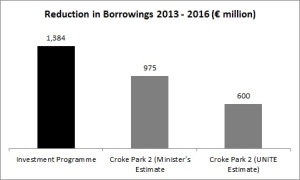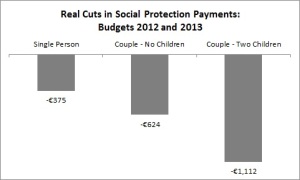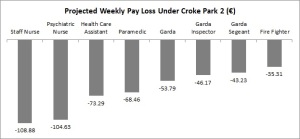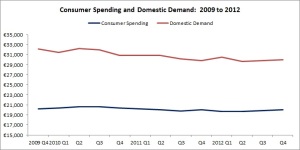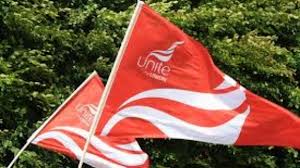Over at Public Policy.ie there is an ‘assessment’ of Croke Park 2 (thanks to Tomboktu for pointing this out). This type of assessment highlights all the problems with debate over policies and just serves up more of the ‘there is no alternative’ argument that has done such damage to the Irish economy. It is ill-informed, full of unsubstantiated assertions, and employs a specious use of data to avoid facing up to the real issues.
After a summary of the measures, it claims that if wages are not cut the Government would have to:
- Cut social protection and medical cards, thus hitting the most disadvantaged even more.
- Cut capital spending which would ‘undermine the potential for future growth in the economy’.
- Increase taxation which could be regressive if it resulted in VAT increases, or drive up the marginal tax rate to one of the highest in the EU.
So there you have it: if we don’t cut public sector wages, we’ll have to cut social welfare or investment; or increase taxes on working people.
First, there is no assessment of why the Government is missing their budgetary targets, no assessment of whether austerity is actually driving down growth and, therefore, destabilising public finances.
Second, there is no assessment of the impact on the deficit – in other words, how much would the Government actually save after the cuts: no assessment of the impact on the consumer economy or private sector employment.
Third, the ‘alternatives’ the article serves up are clearly intended to justify a pre-determined conclusion; namely, we must cut wages. Why not the alternative of increasing investment which would boost growth, employment and, so, tax revenue (while cutting unemployment costs)? Why not the alternative of real reform where unproductive spending would be directed into productive spending?
It is in the area of taxation that the analysis reveals itself as ideologically driven. It doesn’t consider the alternative of removing regressive tax breaks or introducing proper wealth taxes – that is, taxation on financial wealth which would have minimal impact on domestic demand.
It further claims that Ireland has the most ‘progressive tax system in the EU’. It quotes from an OECD study which actually doesn’t measure progressivity in tax systems. It examines the tax wedge (a labour cost analysis); it includes some social protection benefits but not most. While there is not the space to go into this issue here, suffice it to say that if any argument has to fall back on this study it has pretty weak legs.
The Public Policy assessment goes on to claim –again, courtesy of the OECD – that increased taxation on income is more damaging than, say, VAT or property taxes. What it doesn’t cite are the ESRI, NERI or the IMF which shows that spending cuts are more damaging than taxation in general. If it did, it would undermine its own argument.
But the real clanger lies in the conclusion: it cites median pay for employees (median is the point at which 50 percent earn above and 50 percent below – the mid-point, as opposed to the average) as being €28,669 in 2010. It then uses a sleight of hand argument:
Thus the proposed public service pay reductions (other than in relation to overtime and premium pay) begin to take effect at a level which is over twice the median pay level of employees in the public and private sectors.
First, the reductions in higher pay make up on a small proportion of the total cuts – about 25 percent. To use a small part of the pay cuts – while ignoring most – to justify an assertion that the cuts don’t impact on average income earners is hardly befitting a ‘think-tank’.
Second, the median pay used above for employees refers to all workers – full-time, part-time, contract and agency. In 2009, the CSO shows that the median pay for full-time employees (assuming 37 hours average working week) is closer to €37,000.
The fact is that the pay cuts will impact on employees who are in the bottom half of the full-time pay scale. Indeed, the article admits this (and then ignores it) when it states that the ‘basic pay of Staff Nurses begins at just over €30,000.’ And, of course, this doesn’t count the tens of thousands of public sector workers who earn below this but will still be hit by the cuts.
This is what Public Policy.ie has contributed to the debate. All it does is add to the austerity chorus – cut, cut, cut; if not here, then there; if not there, then somewhere else.
And we know where that ends up: where we are now – in a double-dip recession with falling real incomes and rising levels of deprivation.
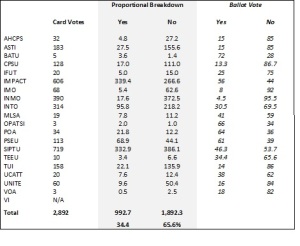 As seen, 66 percent – two-third – rejected this deal. This goes beyond ‘tweaking’ a new deal. This is about a fundamental rejection of the Government’s austerity and wage-cutting programme.
As seen, 66 percent – two-third – rejected this deal. This goes beyond ‘tweaking’ a new deal. This is about a fundamental rejection of the Government’s austerity and wage-cutting programme.